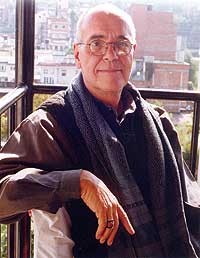
G�tz Hagm�ller remembers driving around Ring Road in the early 1970s when it wasn't a traffic clogged artery, but a beautiful circuit of endless paddy fields and poplars that rushed by in a blur of fresh air. Three decades later, the Valley is an assault on the 63-year-old Austrian conservation architect's aesthetic sense.
But unlike most others who just complain, Hagm�ller decided to stay on and do something about it. It is the work of people like him that we have been able to save what is left of the unique patina of Kathmandu's urbanscape. Here and there, in the niches of the bahals and alleys of Patan and Bhaktapur you can still see Kathmandu's ancient heart.
And it is still beating.
Hagm�ller came to Nepal 30 years ago to work for the German-funded project that transformed the ancient kingdom of Bhaktapur into a World Heritage Site. Over the next 12 years he worked with Nepali and German engineers to restore 200 monuments, and the project helped upgrade the city's water supply, sewage, planning, and economy so that the conservation work would be sustainable.  Fortunately, help came from of local leftists who ran the municipality. The Nepal Workers' Peasants Party in the communist hotbed town took over in an uncanny resemblance to the leftist municipal governments in Rome and Bologna. The proactive policy of Bhaktapur's government has helped keep the Malla period urban ambience of Bhaktapur intact. That political will was critical in making Bhaktapur the best-preserved town in the Valley. They have been audacious enough to bar traffic from the city center, charge a $5 entry fee and then increase it to $10. Though it is a bit steep, it has helped the local government generate revenue, which in turn is used to maintain and conserve the city. "Monument preservation is continuous work, which constantly requires maintenance and repairs," says Hagm�ller.
Fortunately, help came from of local leftists who ran the municipality. The Nepal Workers' Peasants Party in the communist hotbed town took over in an uncanny resemblance to the leftist municipal governments in Rome and Bologna. The proactive policy of Bhaktapur's government has helped keep the Malla period urban ambience of Bhaktapur intact. That political will was critical in making Bhaktapur the best-preserved town in the Valley. They have been audacious enough to bar traffic from the city center, charge a $5 entry fee and then increase it to $10. Though it is a bit steep, it has helped the local government generate revenue, which in turn is used to maintain and conserve the city. "Monument preservation is continuous work, which constantly requires maintenance and repairs," says Hagm�ller.
Hagm�ller's next project was much smaller and much more focussed: the restoration of Patan Museum. Today, the museum is a must-see for Nepali school students, tourists, local expats, visiting dignitaries and heads of state. A medieval palace, the courtyard and the buildings were painstakingly restored to their early glory, the interior completely redone into a modern museum housing Hindu and Buddhist artefacts.
Today, the museum is governed by a semi-governmental board and is self-sustaining through funds raised from entry fees, a restaurant, a museum shop and an exhibition hall. Hagm?ller, who still pops in to see that the display shelves are dusted, the premises maintained and the toilets spotless, can't avoid a twinge of concern. "If the management gets corrupt and careless, then it's bound to collapse," he says.
Hagm�ller's current project is also funded by the Austrian government and is the restoration of an urban area not from the Malla but the Rana period: the Keshar Mahal Gardens in Kathmandu. The gardens stand at the entrance of Thamel, the Valley's lucrative tourist strip, and the government had planned to tear down a neo-classical facade to erect a row of commercial shutter shops.
"If some of us hadn't walked by that day, it would have been gone," he recalls. The restoration is scheduled for completion next year, and Hagm�ller who strongly believes in combining heritage conservation with the means to maintain it, hopes the entrance fees and a small onsite caf? will help in the upkeep.
Hagm�ller's determination to restore and preserve Kathmand's rich cultural and architectural heritage is sharpened by his resignation to the changes brought about modernity and unplanned development. Despite conservation efforts, illegal, ugly unplanned structures are still flouting zoning laws and building codes, while a toothless and poorly-funded Archaeology Department looks on helplessly. "Kathmandu is looking more and more like Vladivostok," he says.
Conservationists like Hagm�ller have long given up trying to save the whole of Kathmandu. It is too late for that now. And it is challenging enough just to save the old urban cores of the three towns, and the smaller villages in the valley. But even that will be quite an accomplishment.


